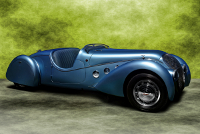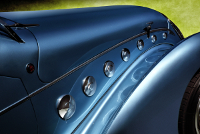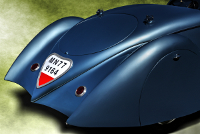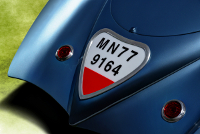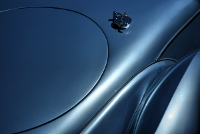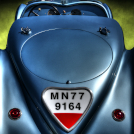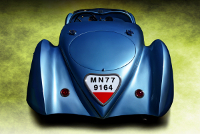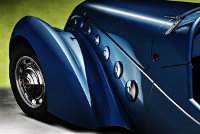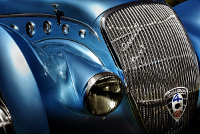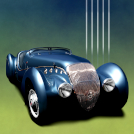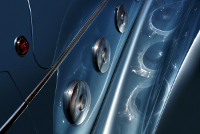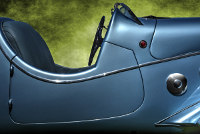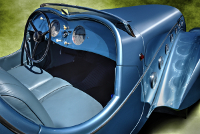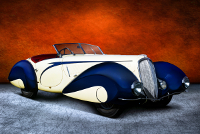Location:
Elegance at Hershey, 2016
Owner: Mark Hyman | St. Louis, Missouri
Prologue:
Image Source 1-15: Nikon D750 (24.3 MP)
Image 6 cropped to 16.1 MP.
Image 10 finished at 36.2 MP.
References:
- UltimateCarPage: A dedicated article on chassis #400247, by Wouter Melissen, March 12, 2010.
- SimanaitisSays: Providing a quick, yet informative summary of the Darl'mat story.
- Hyman Ltd. Classic Cars: Hyman Ltd. always offers a colorful inventory, and now maintains a permanent collection that includes this beautiful roadster.
A simple, and rather prosperous tripart production chain gave birth to this exceptional series of small-capacity sports-racing cars. Peugeot produced the chassis, then shipped it to Emile Darl'mat, a Parisian dealer who had, since before the Great War, produced his own series of uprated cars. Darl'mat kitted out the chassis and drivetrain for sports and competition, adding among other devices a Cotal electromagnetic 4-speed preselector gearbox. Darl'mat then passed the car along to the styling house of Marcel Pourtout, who at the time employed Georges Paulin, for the fitment of lithe coachwork.
Through the development of his many specials, Mssr. Emile's association with the factory became so close that Peugeot accepted his tinkering and tradesmanship with full support. This particular series represented a wish to revive Peugeot's name within contemporary racing circles—in short, to produce a fantastic touring machine similar in spirit to great sports cars from the likes of Bugatti and Delahaye. Emile Darl'mat first chose to mate the smaller, lighter chassis of the 302 with the stronger 2-litre motor from the 402. In turn, Peugeot created a factory 402 Légère specification that did exactly as Darl'mat had done, matching the 302 chassis with 402 drivetrain, thus giving the small custom concern a platform that needed one fewer major modification. In time, Peugeot themselves even referred to the series as the 402 Darl'mat.
Of the coachwork, the combination of a minimalist roadster body on what is actually a medium-size saloon car chassis creates a rather long wheelbase. The whimsical shape is the creation of Georges Paulin, a dentist with a fascination for kinetic design who penned a number of ingenious trappings for small-production European cars. The 402 Darl'mat is, perhaps, the quintessential Paulin design; in terms of influence, the Embiricos Bentley 4 ¼ litre Coupe may have created something of a legacy, but the Peugeot is certainly a car closer to home.
Differences between the 402 and its sporting contemporaries include the use of steel and cast iron, whereas alumininum would have replaced either throughout the body and the motor. The 402 also retains a wood frame, made of ash, to which the body is nailed directly. Darl'mat fitted dual carburetors and that Cotal preselector gearbox, which was popular with racing drivers of the time, but an interesting note about the latter is that the gear selector is mounted in the dashboard. Most applications of preselector gearboxes use a small device mounted on the steering column. But, in Georges Paulin's world of perfect design, it seems no such clutter would be tolerated.
Motor: 1,991 cc straight 4-cylinder, cast iron block and head | 83 mm x 92 mm | 7.4:1 compression
Valvetrain: OHV, 2 valves per cylinder
Aspiration: dual Zenith carburetors
Power: 70 bhp at 4,250 rpm
Drivetrain: Cotal electromagnetic 4-speed preselector gearbox, rear-wheel drive
Front Suspension: double wishbones with transverse semi-elliptic leafsprings and friction dampers
Rear Suspension: live axle with semi-elliptic leafsprings and friction dampers
Architecture: steel ladder-frame chassis with steel coachwork by Pourtout nailed directly to an ash frame
Kerb Weight: 1,020 kg (2,248 lbs)
Wheelbase: 2,880 mm (113.4 inches)
Top Speed: 150 km/h (93 mph)
Etymology:
The '402' designation follows a naming convention started by Peugeot in 1929, and that continues to present day. The nomenclature uses classes to separate series of cars, which in the classic era were divided among 2, 3, and 4-series cars. A zero follows the series number, and then the model number completes the three-digit set. Thence, Peugeot developed the 302 and 402 concurrently, the latter falling between the 401 and the 403. "Darl'mat" is the surname of Monsieur Emile Darl'mat, the Parisian Peugeot dealer who developed numerous specials on Peugeot chassis. During production of this 402 sport-racing series, the factory officially recognized Darl'mat as part of the model's name. We further identify that this 402 is a roadster variant, whereas cabriolets and coupes were also produced. The chassis is #400247, and the coachwork was produced by Pourtout under the direction of designer Georges Paulin. Note that the 402 Darl'mat was also called the "Special Sport" in period, a name noted in chrome on the grille.
Figures:
Production may have extended as far as 105 examples of the 402 Darl'mat, a sizable number considering the individual efforts required to create this remarkable series of cars. Of those 105 cars, the roadster was most plentiful with 53 produced, followed by 32 cabriolets, and a mere 20 coupes. The car depicted here, chassis #400247, is largely original, though it has been totally restored to concours standard.
Lapin Agile: French Whimsy with Performance Purpose
Perhaps the mechanised form of a rabbit in flight, with ears slimmed back along the sides and legs powering outward in a streamlined thrust, the shape of the Darl'mat is a blend of whimsy and science. While certain touches stem from a very French persuasion—not least of which are the bat-wing tail and heart-shaped number plate—the design was perfected with the aid of a wind tunnel. Speaking of wind, the windscreen can be lowered flush into the body by a dashboard crank, demonstrated here in a diminutive position.
The nose features seven medallions per side, the medallions increasing in size as they progress down the flank. These medallions are true vents, as seen in various detail shots. Medallions three through five appear to open around the top perimeter, whereas six and seven open on the bottom. The first two appear to be decorative. Also of note, the bonnet is alligator-hinged, much like a contemporary BMW 328, which is a nod to the modern age.
The 402 Darl'mat has doors, but they are drastically cut down. One decorative line of chrome accentuates the length down the bonnet and under the passenger compartment, pointing out that this is a sizable chassis for just two occupants. Basically a 302 saloon car underneath, Georges Paulin kept the front and rear overhangs to a minimum, emphasizing the car's length, and adding to its sculptural intensity.
Grille Works: The 402 Special Sport Moniker
As noted in the Production section, the 402 Darl'mat was also called the "Special Sport" in period, and this script takes prominence on the grille. The grille itself is a massive, complex curve—a substantial ovoid shell that wraps the entire nose in chrome. A woven stone guard lies just behind. More colorful, the factory 402 badge adorns the starter crank housing, which points out just how tall the grille is in relation to the car's mechanical components.
Paris Pairs: Symmetry in the 402 Darl'mat Tail Design
From the tail, a pair of simple round lights mimics the simple round hatch for the spare tyre. Atop the deck, a pair of beautiful filler caps maintains the balance. And inside the cockpit, a pair of round Jaeger gauges sits evenly in the dashboard. It is interesting to note, first, how the repetition of circular elements across the back of the car meet so well with the curvilinear forms of the flanks. Second, these circles are presaged by the medallion vents on the nose, the plain marker lights, and concentric wheel caps. Of the gauges, note that the Jaeger units are somewhat complex—much like those of the Alfa Romeo 8C 2900—and contain multiple readings within the same face.
Bat Wings: Sharp Tail Streamlining
For all its circles and curves, the 402 Darl'mat Roadster exhibits a few strikingly deliberate angles. Most notably, those three points on the tail recall designs of the 1920s and early 30s in which dart-like treatments and boat-tails are commonplace; they are by nature more angular than fully curved panelcraft, and therefore simpler to form. "Simple" can't be said of the rest of Paulin's sleek design, particularly through the fenders and fascia, with headlamps integrated low against that amazing grille. The flanks, however, hint at the tail in a few ways. First, the front fenders integrate with the body in a sharp point very similar to the finishing treatment of the tail. Then, the angle of the door's front edge is hard and sharp, pointing the eye up and back toward the top of the seats. There, behind the compartment, the chrome ornament hits a stop and makes a near 90-degree turn down the tail. These comprise three very specific angular touches on an otherwise water-like tableau.
While taken well to two-tone liveries, Paulin's design is refreshing in metallic blue. In particular, those features we've noted stand out on a common color—and all the better when that color is a nicely flaked aqua that shifts dynamically as the light runs over its curves. The car sparkles and glows, throws reflections, and bounces light under its skin like shining stones in a river. Yes, I am dramatic, but the 402 Darl'mat deserves prose; it is art and science set in motion.
Last Updated: Feb 13, 2025

